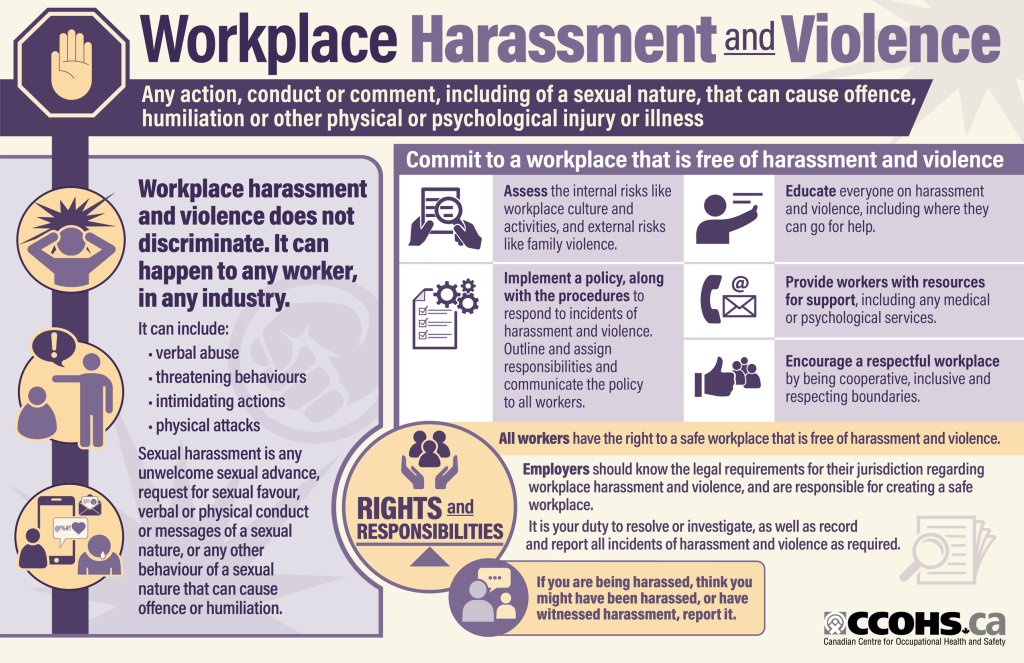

Columns/Blogs
Features
Bullying
Workplace Violence
How to develop a workplace harassment and violence prevention strategy
By The Canadian Centre for Occupational Health and Safety (CCOHS)
 Having a violence prevention program in place is mandatory for many workplaces in Canada. (Light Impression/Adobe Stock)
Having a violence prevention program in place is mandatory for many workplaces in Canada. (Light Impression/Adobe Stock) This commentary was originally shared on OHS Canada, a sister publication of Talent Canada.
Harassment and violence in the workplace can take many forms and it doesn’t always have a single perpetrator and victim.
It might be a poster or calendar on the wall that objectifies women or men. A comic strip taped to the fridge in the break room that makes fun of a specific sexual orientation or gender expression, or a minority. A meme circulating on Slack, Teams or Facebook that targets immigrants or people experiencing poverty.
Harassment and violence can involve verbal abuse, unwanted touch or even hitting, and usually involves a pattern of behaviours with repeated incidents.
As part of their duty to create a healthy and safe environment for workers, employers should develop a comprehensive harassment and violence prevention policy.
The policy should include a reference document, a written statement, mandatory training for employees and managers to learn to recognize all forms of workplace harassment and violence, and safe avenues for reporting and addressing incidences.
Understanding the scope of harassment and violence in Canadian workplaces
In a 2017 online survey conducted by the Government of Canada, 60 per cent of respondents reported having experienced harassment and violence at work. These federal employees indicated that their workplaces had policies on harassment and violence in place but that they had not received training on them.
When developing a harassment and violence prevention policy, it’s important to remember that not all incidents happen in the workplace itself and not all perpetrators are employees.
The COVID-19 pandemic led to a surge in remote work arrangements, with many workers readily accessible to their supervisors and colleagues by email, direct messaging, and video calls.
For example, having to communicate via video means that sometimes incidents of harassment happen virtually, and with no witnesses present. As a result, some employees may decide not to report the harassment and violence they experience for fear of reprisal.
The COVID-19 pandemic has also magnified the potential for incidents of family (or domestic) violence, with physical distancing and remote work measures placing family members in closer and more frequent proximity to each other, while isolating them from supportive friends and co-workers.
There may also be increased tension and potential for violence at home due to additional stress from employment uncertainties or financial pressures from the pandemic.
Family violence can be a workplace issue, and needs to be included as part of a harassment and violence policy.
Educate employees on how to recognize signs that their colleagues might be suffering at home and how to offer assistance. Also provide education to all employees on ways they can signal for help if they’re experiencing domestic violence themselves.
Keep in mind that an employee may also be the perpetrator of family violence. Having a confidential reporting mechanism is critical. Workers should be made aware of how to submit concerns on their own behalf, or if they feel an intervention may be required for a co-worker.
Training for management should also focus on ways to address and support employees in these situations.
New federal rules on violence, harassment in effect: Are you compliant?
Assessing the risks in your workplace
Creating an environment where employees feel safe to discuss and come forward about harassment and violence starts with an assessment of existing hazards.
Some important factors to consider include the nature of work being done, your workplace design and layout, and administrative and work practices.
How are these affected by internal factors such as your culture, conditions, activities, and organizational structure? Think about the influence of external factors such as location, clients, customers, and family violence.
Consider how the mental health of your workplace and harassment and violence may be connected.
- Do you have measures in place to protect the psychological health and safety of your employees?
- Are workers able to control their workload and flag when it’s excessive?
- Are they regularly faced with tight deadlines or having to work long hours?
Stress and feeling a lack of control over their circumstances can make workers more susceptible to bullying behaviour or committing acts of violence. Psychological safety plays an important role in prevention, as does talking to the perpetrator about what prompted their behaviour when incidents occur.
Psychologically Safe Workplace Awards offer both celebration and road map
Your most valuable source of knowledge are your employees and your company history.
Ask employees about their experiences and whether they are concerned for themselves or others. Review any past incidents of violence by checking incident reports, first aid records, and health and safety committee records.
Determine the risk factors your workplace has related to harassment and violence, and evaluate the history of these events in similar places of employment.
Seek out information from any partner organizations, such as your industry association, workers’ compensation board, occupational health and safety regulators or your union office.
Once you’ve collected as much information as you can, look for trends and identify the situations and locations that you believe are most at risk.
Record the results of your assessment, and use them to develop a prevention program. Develop specific recommendations for reducing the risk of violence within your workplace.

Create a road map and make it readily available
Policy, training, and confidential reporting mechanisms are the pillars of a strong harassment and violence prevention strategy.
Seeing your commitment to prevention and to addressing incidents of harassment and violence at work can go a long way in helping hesitant employees feel more comfortable about reporting behaviours that they have witnessed or experienced. It may also help deter employees from engaging in questionable behaviour during workplace interactions.
Using precise, concrete words, your written statement should outline behaviours that management considers inappropriate and unacceptable in the workplace, such as humiliation, violence, intimidation, bullying, and harassment, along with examples of each.
Include instructions on what to do when incidents covered by the policy occur, to whom they should be reported, how confidentiality will be maintained, and the procedure that will be followed each time an incident is reported.
Be clear that reporting is also encouraged when an incident is witnessed rather than experienced directly. Clearly outline the steps that will be followed for resolving or investigating incidents or complaints once they are received.
The statement should be developed by management and employee representatives, including the health and safety committee or representative, and union, if present. It should apply to management and employees, as well as to clients, independent contractors and anyone who has a relationship with your organization.
Commit to an ongoing process of keeping employees safe
As workplaces adapt to a new normal, understanding what harassment and violence look like and how to prevent it is an ongoing process that requires continuous guidance, training and dialogue.
To demonstrate your organization’s commitment, outline the process by which preventive measures will be developed, and set up mandatory training for employees and management on your harassment and violence prevention strategy.
Make sure to communicate about support services for victims, and offer access to a confidential Employee Assistance Program (EAP), if available, where employees can seek help.
Having a violence prevention program in place is mandatory for many workplaces. Contact your legislative authority to determine the specific legislation that applies to your workplace.
The Canadian Centre for Occupational Health and Safety (CCOHS) promotes the total well-being — physical, psychosocial, and mental health — of workers in Canada by providing information, advice, education, and management systems and solutions that support the prevention of injury and illness.
Print this page